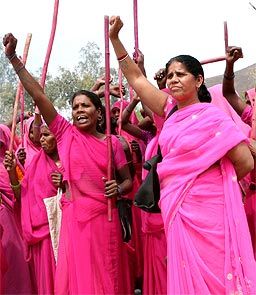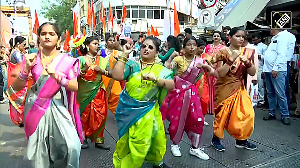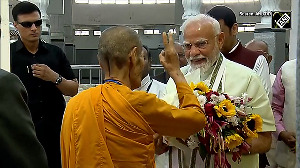 The writing is on the wall -- and it is written in the blood of the women who ‘died’, ‘ran off’ or ‘committed suicide’ under mysterious, carefully unexplained circumstances -- that the only life that matters is one that belongs to an upper class, upper caste, politically connected male.
The writing is on the wall -- and it is written in the blood of the women who ‘died’, ‘ran off’ or ‘committed suicide’ under mysterious, carefully unexplained circumstances -- that the only life that matters is one that belongs to an upper class, upper caste, politically connected male.
It is dark.
All you can hear is the agitated voice of Sampat Pal Devi, asking questions that are lost to the silence of the room.
There are other people with her, relatives of the deceased, but they dare not speak. For which killer would dare confess his crime when his testimony is being recorded?
The blackness of the screen, the muffled whispers with Sampat’s persistent questions (often rhetoric) is suffocating. Instinct tells you that there is something in that room with them, something that is beyond the world of the living, and you cannot shudder but to think of all the possibilities.
When the camera moves, finally finding some light, you see what you have been dreading but were aware of the whole time.
She is dead.
Her body is charred almost completely, like a pile of solid ash in human form frozen in a twisted fashion with her tongue protruding, her legs raised and spread out, struggling even in death -- a child of no more than 16 -- gone, murdered, by her own family.
The in-laws say she did it to herself. The victim’s family appear to have been bought off. You and I may watch in shock about how little the life of a human female means in dusty, old Bundelkhand but Pal expresses little shock.
It is just another day for her.
Director Nishtha Jain followed Sampat Pal Devi around the rigidly patriarchal interiors of Uttar Pradesh for an approximate period of five months, documenting the life of the Gulabi Gang supremo and those of her cadre.
Jain’s film does not manage to do anything new. We all know the statistics -- news anchors scream them from the top of their voices, netas claim to bring them down and a certain crown prince keeps repeated “women empowerment” mechanically. We all know there’s a problem; and that, as a country, we are far from solving it.
However, what Gulabi Gang does do is bring to our attention that women are not just numbers. Violence is not just a bad dream that lives far away. Fear is not an alien reality. There is no way you can sit through this documentary and not give a damn.
Gulabi Gang reveals little of the real Gulabi Gang in the 96 minutes that it runs, delving even more briefly for Sampat Pal Devi’s reasons for founding it in 2006. Jain’s documentary is all over the place, failing to pick a single direction and though Jain’s intentions are clearly noble, she is unable get into the nitty-gritty of the cases she chooses to portray -- save for one.
Gulabi Gang indulges in stunning shots of the native wildlife of Uttar Pradesh, the camera panning over scenic fields or lakes -- but perhaps it would have been more effective if it had looked harder into the lives of the women who founded it and those who fell victim to this vigilante group’s anger.
Sampat Pal seems eerily at ease with a lens being pointed at her at all times, almost encouraging of Jain’s questions. One wonders how Pal got this way, if the limelight has changed her and if the camera tempers her behaviour in any way. Jain, on her part, could have avoided making statements (disguised as questions) in emotionally volatile situations.
Gulabi Gang leaves you wanting more -- mostly because a story so fascinating remains largely unexplored. An extensive Google search on the subject could be a lot more beneficial but for the lack of visual impact that serves as enough shock value to make the audience think for a bit.
The film is alsocharacterised by bad editing.
The saving grace of the documentary is the subject it chooses to portray.
In a country where 39,000 child marriages take place every day, making India the contributor of 40 percent of all the world’s child brides (ahead of even sub-Saharan Africa), organisations like the Gulabi Gang offer much needed hope.
In contrast with the British documentary Pink Saris, which primarily saw the Gulabi Gang as a vigilante group, Gulabi Gang sees it transform into a semi-political organisation. Members of the Gulabi Gang have now begun to contest elections -- the consequences of which Jain captures beautifully.
Nishtha Jain certainly has an eye for irony. She never fails to capture the paradoxes that plague rural UP’s highly hierarchical society. Several Gulabi Gang members, though against the exploitation of women, prefer to cover their faces with their pallus. A large majority remain uneducated and the lathi yielding seems more of a ceremonial dance than a martial art.
Jain’s prowess as a documentarian comes to light only while she follows Husna Jahan -- an ex-member of the Gulabi Gang -- who used her clout to save her brother who is accused to stabbing their sister to death for marrying a second time.
Husna was previously observed campaigning zealously for the Gulabi Gang’s cause but refuses to go against her brother since she believes that her sister has committed an act of 'lose morals' buy re-marrying a man she loved.
Husna goes on to justify the murder by saying that she wouldn’t stop her own sons from ‘disciplining’ any of their sisters if they committed a ‘sin’.
Coming from a woman who was working for a women’s organisation, it is scary to probe the extent of negative, patriarchal attitudes that women have internalised over the centuries. Even now, in the 21st century, when human rights and a feudal mindset meet, the winner is apparent.
The writing is on the wall -- and it is written in the blood of the women who ‘died’, ‘ran off’ or ‘committed suicide’ under mysterious, carefully unexplained circumstances -- that the only life that matters is one that belongs to an upper class, upper caste, politically connected male.
The rest are inconsequential.
Even though the camera moves on from the burnt body within minutes, this country will always be stuck there, in those few frames, until more documentaries like Gulabi Gang are made and viewed by the mainstream audience.
Gulabi Gang is not my favourite documentary by far but despite its shortcomings it is an extremely important one -- especially in the current socio-political climate where up to 65 million females have ‘disappeared’ from the population.
It is estimated that by 2020, there will be 20 percent more males than females in India. This percentage might seem like a small one but 20 percent of 1.25 billion people can amount to a large number. In such circumstances, women like Sampat Pal are forced to take up arms -- or rather, lathis -- and circumvent an impotent law (and law enforcement) that does not even guarantee basic human respect to anyone with ovaries.
As a film, Gulabi Gang could have been a lot better but its limitations should not restrict anyone from watching it. You will only come out wiser, and hopefully, a lot more aware of your privileges -- God knows I was.











 © 2025
© 2025